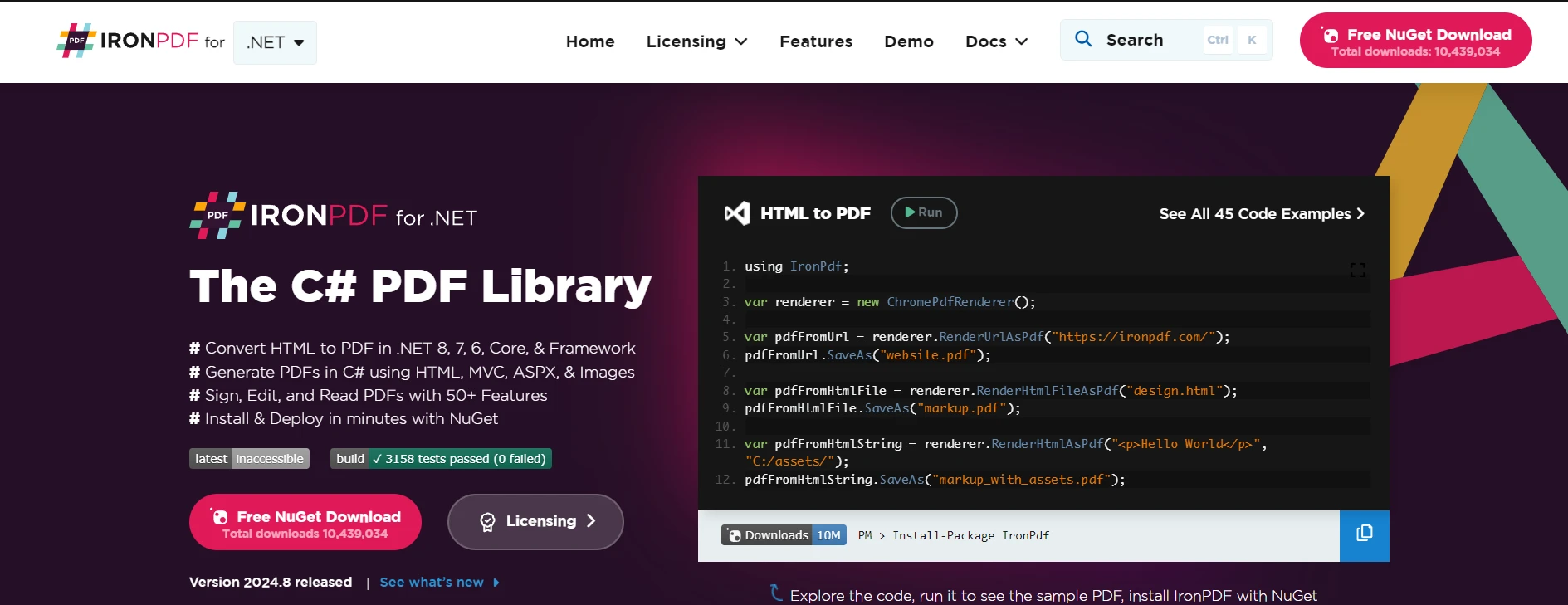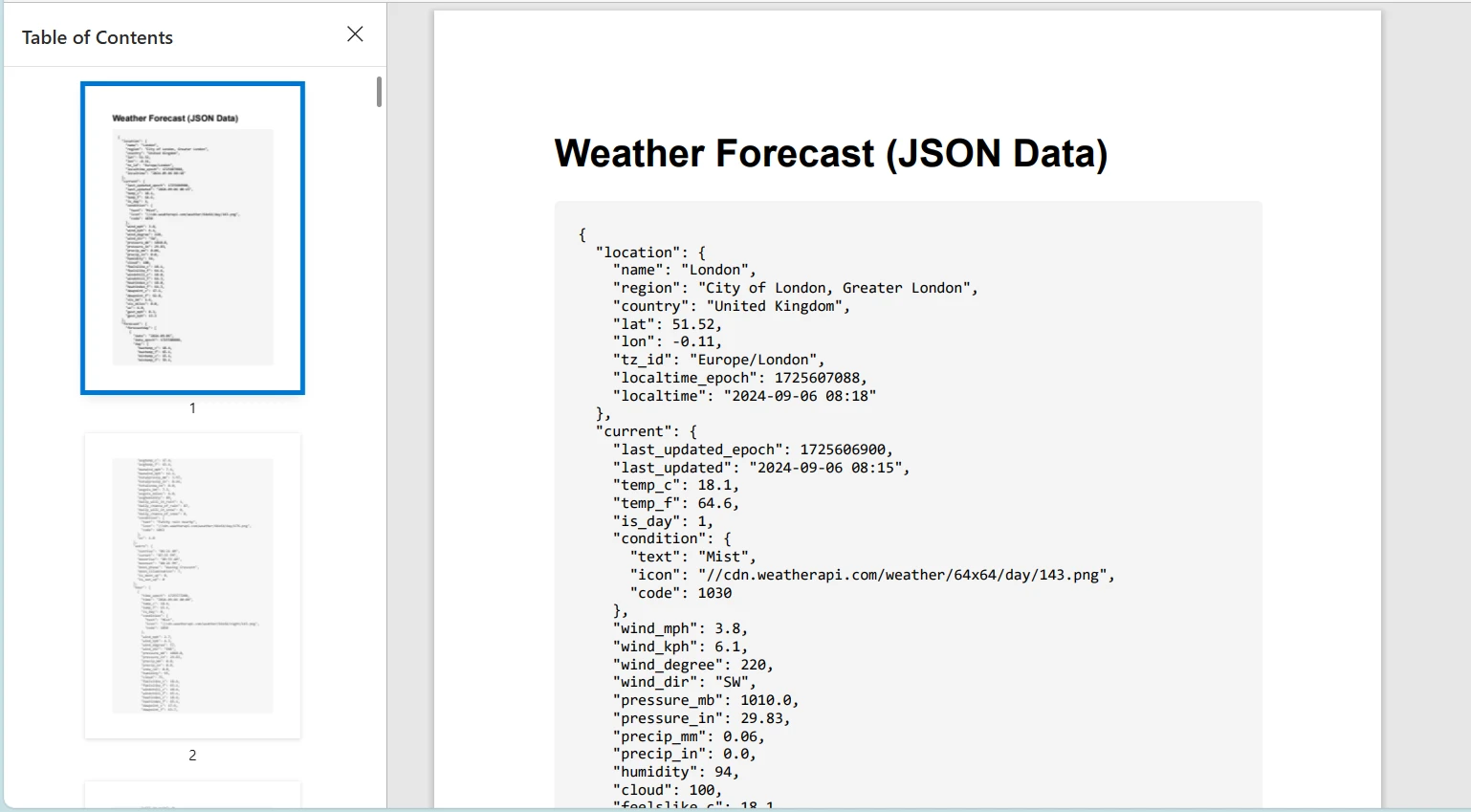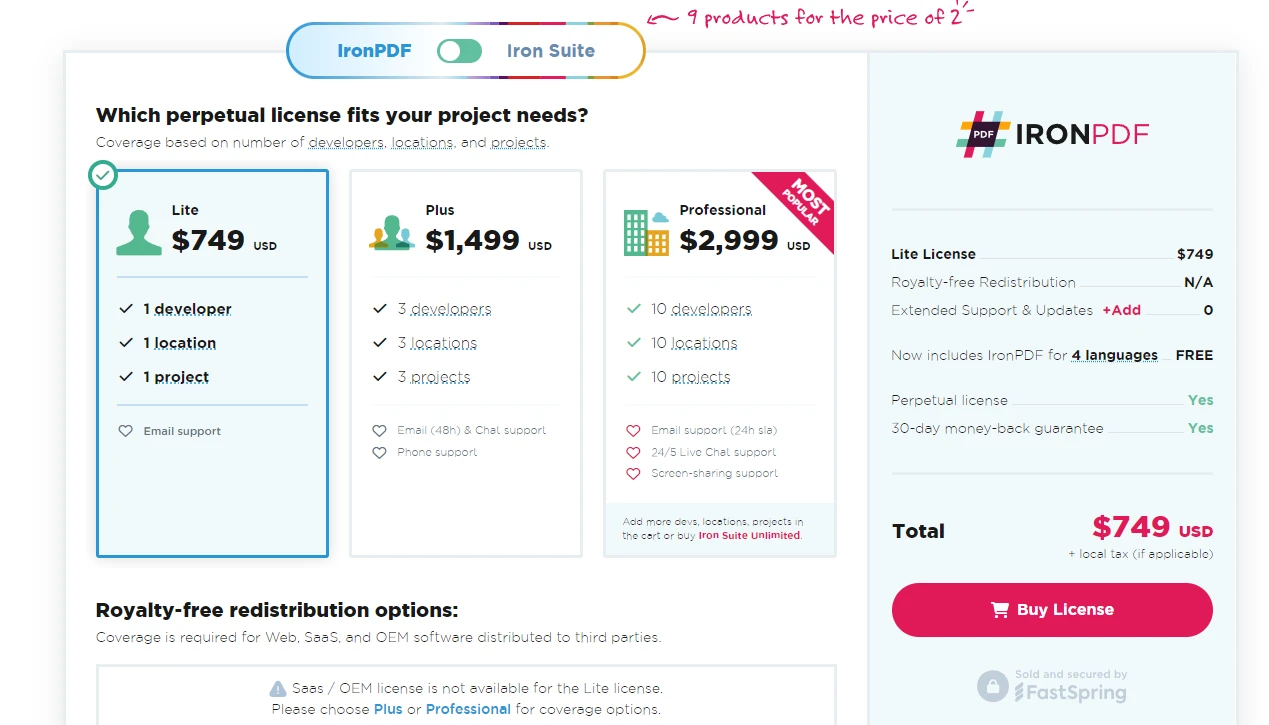Pruebe en producción sin marcas de agua.
Funciona donde lo necesite.
Obtén 30 días de producto totalmente funcional.
Ténlo en funcionamiento en minutos.
Acceso completo a nuestro equipo de asistencia técnica durante la prueba del producto
EnClase HttpClient.NET Framework, proporciona métodos para enviar solicitudes HTTP y recibir respuestas HTTP de un recurso identificado por un URI. Simplifica la realización de llamadas a peticiones HTTP, ya se trate de peticiones GET, POST, PUT o DELETE. Esta guía cubrirá el uso esencial de HttpClient en escenarios prácticos e introducirá elBiblioteca IronPDF.
La clase HttpClient se utiliza para enviar peticiones HTTP. Puede crear una nueva instancia de la siguiente manera:
using System;
using System.Net.Http;
class Program
{
static async Task Main(string[] args)
{
using var client = new HttpClient(); //HttpClient client
var response = await client.GetAsync("https://api.weatherapi.com/v1/current.json?key=YOUR_API_KEY&q=London"); // HTTP response for GET request
var responseBody = await response.Content.ReadAsStringAsync(); // response content
Console.WriteLine(responseBody);
}
}using System;
using System.Net.Http;
class Program
{
static async Task Main(string[] args)
{
using var client = new HttpClient(); //HttpClient client
var response = await client.GetAsync("https://api.weatherapi.com/v1/current.json?key=YOUR_API_KEY&q=London"); // HTTP response for GET request
var responseBody = await response.Content.ReadAsStringAsync(); // response content
Console.WriteLine(responseBody);
}
}Imports System
Imports System.Net.Http
Friend Class Program
Shared Async Function Main(ByVal args() As String) As Task
Dim client = New HttpClient() 'HttpClient client
Dim response = Await client.GetAsync("https://api.weatherapi.com/v1/current.json?key=YOUR_API_KEY&q=London") ' HTTP response for GET request
Dim responseBody = Await response.Content.ReadAsStringAsync() ' response content
Console.WriteLine(responseBody)
End Function
End ClassEn este ejemplo:
Realizar una solicitud HTTP GET y gestionar la respuesta:
var client = new HttpClient();
var response = await client.GetAsync("https://api.weatherapi.com/v1/current.json?key=YOUR_API_KEY&q=Paris");
if (response.IsSuccessStatusCode)
{
var responseBody = await response.Content.ReadAsStringAsync();
Console.WriteLine(responseBody);
}var client = new HttpClient();
var response = await client.GetAsync("https://api.weatherapi.com/v1/current.json?key=YOUR_API_KEY&q=Paris");
if (response.IsSuccessStatusCode)
{
var responseBody = await response.Content.ReadAsStringAsync();
Console.WriteLine(responseBody);
}Dim client = New HttpClient()
Dim response = Await client.GetAsync("https://api.weatherapi.com/v1/current.json?key=YOUR_API_KEY&q=Paris")
If response.IsSuccessStatusCode Then
Dim responseBody = Await response.Content.ReadAsStringAsync()
Console.WriteLine(responseBody)
End IfEnviar una solicitud POST implica añadir un cuerpo de solicitud:
var client = new HttpClient();
var requestBody = new StringContent("{ \"location\": \"New York\" }", Encoding.UTF8, "application/json");
var response = await client.PostAsync("https://api.weatherapi.com/v1/forecast.json?key=YOUR_API_KEY", requestBody);
if (response.IsSuccessStatusCode)
{
var responseBody = await response.Content.ReadAsStringAsync();
Console.WriteLine(responseBody);
}var client = new HttpClient();
var requestBody = new StringContent("{ \"location\": \"New York\" }", Encoding.UTF8, "application/json");
var response = await client.PostAsync("https://api.weatherapi.com/v1/forecast.json?key=YOUR_API_KEY", requestBody);
if (response.IsSuccessStatusCode)
{
var responseBody = await response.Content.ReadAsStringAsync();
Console.WriteLine(responseBody);
}Dim client = New HttpClient()
Dim requestBody = New StringContent("{ ""location"": ""New York"" }", Encoding.UTF8, "application/json")
Dim response = Await client.PostAsync("https://api.weatherapi.com/v1/forecast.json?key=YOUR_API_KEY", requestBody)
If response.IsSuccessStatusCode Then
Dim responseBody = Await response.Content.ReadAsStringAsync()
Console.WriteLine(responseBody)
End IfUna solicitud HTTP PUT actualiza los recursos:
var client = new HttpClient();
var requestBody = new StringContent("{ \"location\": \"Tokyo\", \"days\": 3 }", Encoding.UTF8, "application/json");
var response = await client.PutAsync("https://api.weatherapi.com/v1/forecast.json?key=YOUR_API_KEY", requestBody);
if (response.IsSuccessStatusCode)
{
var responseBody = await response.Content.ReadAsStringAsync();
Console.WriteLine(responseBody);
}var client = new HttpClient();
var requestBody = new StringContent("{ \"location\": \"Tokyo\", \"days\": 3 }", Encoding.UTF8, "application/json");
var response = await client.PutAsync("https://api.weatherapi.com/v1/forecast.json?key=YOUR_API_KEY", requestBody);
if (response.IsSuccessStatusCode)
{
var responseBody = await response.Content.ReadAsStringAsync();
Console.WriteLine(responseBody);
}Dim client = New HttpClient()
Dim requestBody = New StringContent("{ ""location"": ""Tokyo"", ""days"": 3 }", Encoding.UTF8, "application/json")
Dim response = Await client.PutAsync("https://api.weatherapi.com/v1/forecast.json?key=YOUR_API_KEY", requestBody)
If response.IsSuccessStatusCode Then
Dim responseBody = Await response.Content.ReadAsStringAsync()
Console.WriteLine(responseBody)
End IfPara enviar una solicitud HTTP DELETE:
var client = new HttpClient();
var response = await client.DeleteAsync("https://api.weatherapi.com/v1/locations/1?key=YOUR_API_KEY");
if (response.IsSuccessStatusCode)
{
Console.WriteLine("Resource deleted successfully");
}var client = new HttpClient();
var response = await client.DeleteAsync("https://api.weatherapi.com/v1/locations/1?key=YOUR_API_KEY");
if (response.IsSuccessStatusCode)
{
Console.WriteLine("Resource deleted successfully");
}Dim client = New HttpClient()
Dim response = Await client.DeleteAsync("https://api.weatherapi.com/v1/locations/1?key=YOUR_API_KEY")
If response.IsSuccessStatusCode Then
Console.WriteLine("Resource deleted successfully")
End IfCada solicitud HTTP devuelve un objeto HttpResponseMessage, que incluye el cuerpo de la respuesta, las cabeceras y el código de estado. Por ejemplo:
var response = await client.GetAsync("https://api.weatherapi.com/v1/current.json?key=YOUR_API_KEY&q=Sydney");
if (response.IsSuccessStatusCode)
{
var responseBody = await response.Content.ReadAsStringAsync();
Console.WriteLine(responseBody);
}
else
{
Console.WriteLine($"Error: {response.StatusCode}");
}var response = await client.GetAsync("https://api.weatherapi.com/v1/current.json?key=YOUR_API_KEY&q=Sydney");
if (response.IsSuccessStatusCode)
{
var responseBody = await response.Content.ReadAsStringAsync();
Console.WriteLine(responseBody);
}
else
{
Console.WriteLine($"Error: {response.StatusCode}");
}Dim response = Await client.GetAsync("https://api.weatherapi.com/v1/current.json?key=YOUR_API_KEY&q=Sydney")
If response.IsSuccessStatusCode Then
Dim responseBody = Await response.Content.ReadAsStringAsync()
Console.WriteLine(responseBody)
Else
Console.WriteLine($"Error: {response.StatusCode}")
End IfLas instancias de HttpClient deben reutilizarse para aprovechar la agrupación de conexiones y evitar agotar los recursos del sistema. Un patrón típico es crear una única instancia de HttpClient para toda la vida de su aplicación o servicio. Esto puede hacerse utilizando una variable estática o inyección de dependencia para aplicaciones web.
public static class HttpClientProvider
{
private static readonly HttpClient client = new HttpClient();
public static HttpClient Client => client;
}public static class HttpClientProvider
{
private static readonly HttpClient client = new HttpClient();
public static HttpClient Client => client;
}Public Module HttpClientProvider
'INSTANT VB NOTE: The field client was renamed since Visual Basic does not allow fields to have the same name as other class members:
Private ReadOnly client_Conflict As New HttpClient()
Public ReadOnly Property Client() As HttpClient
Get
Return client_Conflict
End Get
End Property
End ModuleLa instancia HttpClient se reutiliza en toda la aplicación, lo que reduce la sobrecarga de crear nuevas conexiones HTTP.
En una aplicación web, el enfoque recomendado es registrar HttpClient como un servicio singleton:
public void ConfigureServices(IServiceCollection services)
{
services.AddHttpClient();
}public void ConfigureServices(IServiceCollection services)
{
services.AddHttpClient();
}Public Sub ConfigureServices(ByVal services As IServiceCollection)
services.AddHttpClient()
End SubTambién puede crear clientes con nombre y clientes tipificados para configuraciones más específicas.
Al reutilizar las instancias de HttpClient, se beneficia de la agrupación de conexiones, que mejora el rendimiento de varias solicitudes al mismo servidor. También puede configurar los ajustes del proxy utilizando la clase HttpClientHandler:
var handler = new HttpClientHandler
{
Proxy = new WebProxy("http://proxyserver:port"),
UseProxy = true
};
var client = new HttpClient(handler);var handler = new HttpClientHandler
{
Proxy = new WebProxy("http://proxyserver:port"),
UseProxy = true
};
var client = new HttpClient(handler);Dim handler = New HttpClientHandler With {
.Proxy = New WebProxy("http://proxyserver:port"),
.UseProxy = True
}
Dim client = New HttpClient(handler)Para manejar diferentes códigos de estado HTTP, compruebe la propiedad HttpResponseMessage.StatusCode:
using System;
using System.Net;
using System.Net.Http;
using System.Threading.Tasks;
async Task MakeRequestAsync()
{
try
{
using var client = new HttpClient();
var response = await client.GetAsync("https://api.weatherapi.com/v1/current.json?key=YOUR_API_KEY&q=Berlin");
// Response Status Code Cases
switch (response.StatusCode)
{
case HttpStatusCode.OK:
Console.WriteLine("Success");
var content = await response.Content.ReadAsStringAsync();
Console.WriteLine($"Response content: {content}");
break;
case HttpStatusCode.NotFound:
Console.WriteLine("Resource not found");
break;
case HttpStatusCode.Unauthorized:
Console.WriteLine("Unauthorized access");
break;
case HttpStatusCode.InternalServerError:
Console.WriteLine("Server error occurred");
break;
default:
Console.WriteLine($"Unexpected status code: {response.StatusCode}");
break;
}
}
catch (HttpRequestException e)
{
Console.WriteLine($"Request error: {e.Message}");
}
catch (Exception e)
{
Console.WriteLine($"An error occurred: {e.Message}");
}
}using System;
using System.Net;
using System.Net.Http;
using System.Threading.Tasks;
async Task MakeRequestAsync()
{
try
{
using var client = new HttpClient();
var response = await client.GetAsync("https://api.weatherapi.com/v1/current.json?key=YOUR_API_KEY&q=Berlin");
// Response Status Code Cases
switch (response.StatusCode)
{
case HttpStatusCode.OK:
Console.WriteLine("Success");
var content = await response.Content.ReadAsStringAsync();
Console.WriteLine($"Response content: {content}");
break;
case HttpStatusCode.NotFound:
Console.WriteLine("Resource not found");
break;
case HttpStatusCode.Unauthorized:
Console.WriteLine("Unauthorized access");
break;
case HttpStatusCode.InternalServerError:
Console.WriteLine("Server error occurred");
break;
default:
Console.WriteLine($"Unexpected status code: {response.StatusCode}");
break;
}
}
catch (HttpRequestException e)
{
Console.WriteLine($"Request error: {e.Message}");
}
catch (Exception e)
{
Console.WriteLine($"An error occurred: {e.Message}");
}
}Imports System
Imports System.Net
Imports System.Net.Http
Imports System.Threading.Tasks
Async Function MakeRequestAsync() As Task
Try
Dim client = New HttpClient()
Dim response = Await client.GetAsync("https://api.weatherapi.com/v1/current.json?key=YOUR_API_KEY&q=Berlin")
' Response Status Code Cases
Select Case response.StatusCode
Case HttpStatusCode.OK
Console.WriteLine("Success")
Dim content = Await response.Content.ReadAsStringAsync()
Console.WriteLine($"Response content: {content}")
Case HttpStatusCode.NotFound
Console.WriteLine("Resource not found")
Case HttpStatusCode.Unauthorized
Console.WriteLine("Unauthorized access")
Case HttpStatusCode.InternalServerError
Console.WriteLine("Server error occurred")
Case Else
Console.WriteLine($"Unexpected status code: {response.StatusCode}")
End Select
Catch e As HttpRequestException
Console.WriteLine($"Request error: {e.Message}")
Catch e As Exception
Console.WriteLine($"An error occurred: {e.Message}")
End Try
End FunctionA menudo se trabaja con respuestas JSON. Puede deserializar el contenido de la respuesta en un objeto fuertemente tipado:
using System.Net.Http;
using System.Text.Json;
using System.Threading.Tasks;
var client = new HttpClient();
var response = await client.GetAsync("https://api.weatherapi.com/v1/current.json?key=YOUR_API_KEY&q=London");
var jsonString = await response.Content.ReadAsStringAsync();
var weatherResponse = JsonSerializer.Deserialize<WeatherResponse>(jsonString);
public class WeatherResponse
{
public string Location { get; set; }
public double Temperature { get; set; }
}using System.Net.Http;
using System.Text.Json;
using System.Threading.Tasks;
var client = new HttpClient();
var response = await client.GetAsync("https://api.weatherapi.com/v1/current.json?key=YOUR_API_KEY&q=London");
var jsonString = await response.Content.ReadAsStringAsync();
var weatherResponse = JsonSerializer.Deserialize<WeatherResponse>(jsonString);
public class WeatherResponse
{
public string Location { get; set; }
public double Temperature { get; set; }
}Imports System.Net.Http
Imports System.Text.Json
Imports System.Threading.Tasks
Private client = New HttpClient()
Private response = await client.GetAsync("https://api.weatherapi.com/v1/current.json?key=YOUR_API_KEY&q=London")
Private jsonString = await response.Content.ReadAsStringAsync()
Private weatherResponse = JsonSerializer.Deserialize(Of WeatherResponse)(jsonString)
Public Class WeatherResponse
Public Property Location() As String
Public Property Temperature() As Double
End ClassEl método ReadAsStringAsync simplifica la lectura de contenido JSON directamente en objetos C#.

IronPDF es una biblioteca PDF .NET diseñada para crear, manipular y convertir archivos PDF en C#. Se utiliza ampliamente paragenerar PDF de alta calidad a partir de HTMLel texto debe estar en formato .NET, CSS, JavaScript y otros formatos. IronPDF ofrece funciones como conversión de HTML a PDF, fusión de PDF, marcas de agua e incluso operaciones avanzadas como firmas digitales y cifrado de PDF. Es compatible con varias plataformas, como Windows, Linux y macOS, lo que lo convierte en una solución versátil para el desarrollo multiplataforma.
La combinación de IronPDF con la clase HttpClient en C# es una forma eficaz de generar y manipular documentos PDF a partir de recursos web de forma dinámica. Por ejemplo, puede recuperar contenido HTML de una URL mediante HttpClient y, a continuación, convertir este HTML en un documento PDF utilizando IronPDF. Esto es útil a la hora de generar informes, facturas o cualquier documento basado dinámicamente en contenido web en directo.
using System;
using System.Net.Http;
using System.Threading.Tasks;
using System.Text.Json;
using IronPdf;
class Program
{
static async Task Main(string[] args)
{
License.LicenseKey = "IRONSUITE.WINSWRITERSIRONSOFTWARECOM.31102-3E7C9B3308-CIHWVP2-L2A7FVEBUSFN-DP6CI32YVXIN-45HQSAZOBOCW-YCYETGS4ENQX-NZXXG4YCPAYI-EBCIJ43PNLJW-DKWC7U-TFXPQ4LKLXGPEA-DEPLOYMENT.TRIAL-G43TTA.TRIAL.EXPIRES.20.MAY.2025";
using var client = new HttpClient();
var response = await client.GetAsync("https://api.weatherapi.com/v1/forecast.json?key=55c9040a6ad34c6c90470702240609&q=London&days=3");
if (response.IsSuccessStatusCode)
{
var jsonContent = await response.Content.ReadAsStringAsync();
// Pretty-print the JSON
var jsonElement = JsonSerializer.Deserialize<JsonElement>(jsonContent);
var formattedJson = JsonSerializer.Serialize(jsonElement, new JsonSerializerOptions { WriteIndented = true });
// Escape the JSON for HTML
formattedJson = System.Web.HttpUtility.HtmlEncode(formattedJson);
var htmlContent = $@"
<html>
<head>
<style>
body {{ font-family: Arial, sans-serif; }}
pre {{ background-color: #f4f4f4; padding: 20px; border-radius: 5px; white-space: pre-wrap; word-wrap: break-word; }}
</style>
</head>
<body>
<h1>Weather Forecast (JSON Data)</h1>
<pre>{formattedJson}</pre>
</body>
</html>";
var renderer = new ChromePdfRenderer();
var pdf = renderer.RenderHtmlAsPdf(htmlContent);
pdf.SaveAs("F://weather_report.pdf");
Console.WriteLine("PDF generated successfully!");
}
else
{
Console.WriteLine($"Failed to retrieve content. Status code: {response.StatusCode}");
}
}
}using System;
using System.Net.Http;
using System.Threading.Tasks;
using System.Text.Json;
using IronPdf;
class Program
{
static async Task Main(string[] args)
{
License.LicenseKey = "IRONSUITE.WINSWRITERSIRONSOFTWARECOM.31102-3E7C9B3308-CIHWVP2-L2A7FVEBUSFN-DP6CI32YVXIN-45HQSAZOBOCW-YCYETGS4ENQX-NZXXG4YCPAYI-EBCIJ43PNLJW-DKWC7U-TFXPQ4LKLXGPEA-DEPLOYMENT.TRIAL-G43TTA.TRIAL.EXPIRES.20.MAY.2025";
using var client = new HttpClient();
var response = await client.GetAsync("https://api.weatherapi.com/v1/forecast.json?key=55c9040a6ad34c6c90470702240609&q=London&days=3");
if (response.IsSuccessStatusCode)
{
var jsonContent = await response.Content.ReadAsStringAsync();
// Pretty-print the JSON
var jsonElement = JsonSerializer.Deserialize<JsonElement>(jsonContent);
var formattedJson = JsonSerializer.Serialize(jsonElement, new JsonSerializerOptions { WriteIndented = true });
// Escape the JSON for HTML
formattedJson = System.Web.HttpUtility.HtmlEncode(formattedJson);
var htmlContent = $@"
<html>
<head>
<style>
body {{ font-family: Arial, sans-serif; }}
pre {{ background-color: #f4f4f4; padding: 20px; border-radius: 5px; white-space: pre-wrap; word-wrap: break-word; }}
</style>
</head>
<body>
<h1>Weather Forecast (JSON Data)</h1>
<pre>{formattedJson}</pre>
</body>
</html>";
var renderer = new ChromePdfRenderer();
var pdf = renderer.RenderHtmlAsPdf(htmlContent);
pdf.SaveAs("F://weather_report.pdf");
Console.WriteLine("PDF generated successfully!");
}
else
{
Console.WriteLine($"Failed to retrieve content. Status code: {response.StatusCode}");
}
}
}Imports System
Imports System.Net.Http
Imports System.Threading.Tasks
Imports System.Text.Json
Imports IronPdf
Friend Class Program
Shared Async Function Main(ByVal args() As String) As Task
License.LicenseKey = "IRONSUITE.WINSWRITERSIRONSOFTWARECOM.31102-3E7C9B3308-CIHWVP2-L2A7FVEBUSFN-DP6CI32YVXIN-45HQSAZOBOCW-YCYETGS4ENQX-NZXXG4YCPAYI-EBCIJ43PNLJW-DKWC7U-TFXPQ4LKLXGPEA-DEPLOYMENT.TRIAL-G43TTA.TRIAL.EXPIRES.20.MAY.2025"
Dim client = New HttpClient()
Dim response = Await client.GetAsync("https://api.weatherapi.com/v1/forecast.json?key=55c9040a6ad34c6c90470702240609&q=London&days=3")
If response.IsSuccessStatusCode Then
Dim jsonContent = Await response.Content.ReadAsStringAsync()
' Pretty-print the JSON
Dim jsonElement = JsonSerializer.Deserialize(Of JsonElement)(jsonContent)
Dim formattedJson = JsonSerializer.Serialize(jsonElement, New JsonSerializerOptions With {.WriteIndented = True})
' Escape the JSON for HTML
formattedJson = System.Web.HttpUtility.HtmlEncode(formattedJson)
Dim htmlContent = $"
<html>
<head>
<style>
body {{ font-family: Arial, sans-serif; }}
pre {{ background-color: #f4f4f4; padding: 20px; border-radius: 5px; white-space: pre-wrap; word-wrap: break-word; }}
</style>
</head>
<body>
<h1>Weather Forecast (JSON Data)</h1>
<pre>{formattedJson}</pre>
</body>
</html>"
Dim renderer = New ChromePdfRenderer()
Dim pdf = renderer.RenderHtmlAsPdf(htmlContent)
pdf.SaveAs("F://weather_report.pdf")
Console.WriteLine("PDF generated successfully!")
Else
Console.WriteLine($"Failed to retrieve content. Status code: {response.StatusCode}")
End If
End Function
End Class
Recuerde sustituir "YOUR_API_KEY" por una clave API cuando utilice una API meteorológica real.

Este tutorial explora el uso de la clase HttpClient en C# para enviar peticiones HTTP y manejar respuestas. También presentamos IronPDF, una potente biblioteca para generar archivos PDF en aplicaciones .NET. Demostramos cómo combinar estas tecnologías recuperando contenido HTML de un servicio web mediante HttpClient y convirtiéndolo a PDF con IronPDF.
IronPDF ofrece una prueba gratuita, y sus licencias comienzan desde $749, lo que lo convierte en una herramienta valiosa para los desarrolladores que buscan capacidades integrales de generación de PDF.